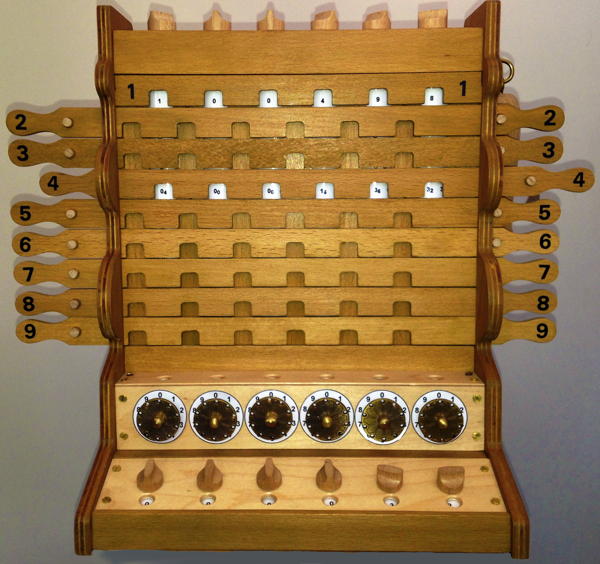
Wilhelm Schickard (1592–1635),1 a German mathematician and clergyman, designed and built a device which could add, subtract, multiply and divide which he called the “calculating clock.”2 The machine was based on the newly invented “Napier’s Rods” which in a particularly efficient form constitute the vertical section of the machine. The approach appears to anticipate the embodiment of Napier’s rods developed by Gaspar Schott who in 1668 turned the rods into cylinders and fixed them in a box (“cistula”) so that the right one could be made visible simply with a turn of the knob. A similar cistula, in Schickard’s machine, is mounted above an adding machine based on interconnected gear wheels.
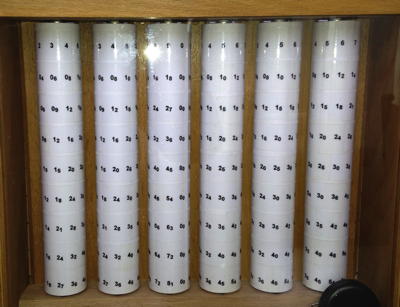
Schickard rear view showing Napier cistular cylinders
At the front of the adding machine can be seen small disks which can be rotated with a pointer by 1 to 9 divisions. Behind the disk a gear wheel is turned which, when it passes from “9” to “0” engages with the wheel to the right to move it by one unit. As well as this “carry” mechanism in the box at the base, a further register is provided for storing numbers at intermediate stages in calculations. None of Schickard’s devices have survived and it is not clear that one was ever actually completed. However, various replicas have been constructed from the drawings and description left in a letter from Schickard to Keppler. One replica is in this collection.

Schickard front panel
A caveat needs to be inserted that the Schickard drawing does not work when implemented as shown when a large number of carries must be done simultaneously (for example when 1 is to be added to 899999 to give 900000) because too much force is required to move all the wheels by the required amount at once. A simple mechanical improvement can allow this to happen, but whether it was ever used on a Schickard machine, if one was actually ever constructed in final form, remains a mystery.
This smoothly and fully working replica was constructed through a collaboration of three European public museums and one private museum, under the coordination of Reinhold Rehbein, and draws heavily also on the pioneering work of Baron Bruno v. Freytag3 who constructed the first replica in 1957. (This replica shares with the Schickard drawing the problem of not being able to cope with long simultaneous carries.) The replica was later modified by replacing the disks in the front panel with brass replica discs and nuts beautifully designed and constructed by Jan Meyer. At the same time brass screws were substituted for the earlier steel screws. A well structured set of instructions on the use of the Schickard calculator can be found in an article by Friedrich W. Kisterman.4
For more see the extracts from the text of letters from Schickard to Kepler, sketches of mechanism, and notes to artisans constructing the final machine.
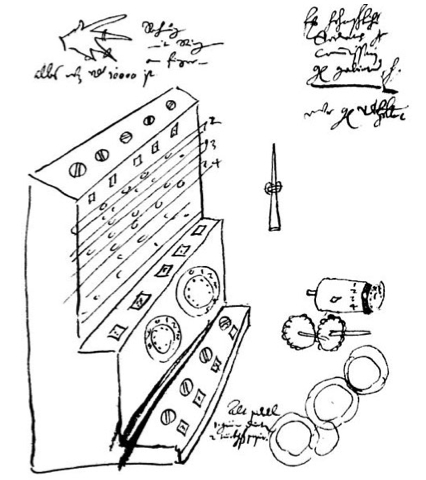 |  |
| Original sketch by Schickard ~16235 | Reconstruction from Schickard’s descriptions (Collection Calculant) |
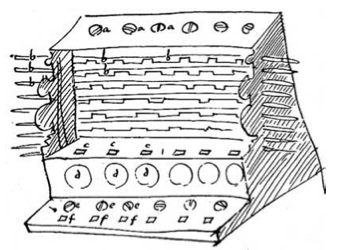 | 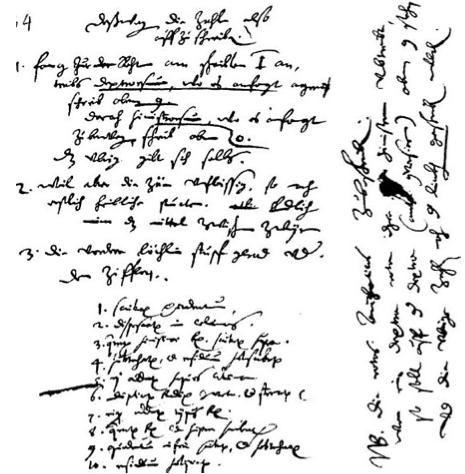 |
| Second sketch by Schickard6 | Note by Schickard to artisans building his machine7 |
1 For a short biography of Schickard see http://history-computer.com/People/SchickardBio.html (viewed 4 Jan 2012 (↑)
2 For more on the Schickard see for example, http://history-computer.com/MechanicalCalculators/Pioneers/Schickard.html (viewed 3 Jan 2012). (↑)
3 For a brief biographical sketch of Baron Freytag see http://www.begriffslogik.de/personen/freytag.html (viewed 4 Jan 2012) (↑)
4 Friedrich W. Kisterman, “How to use the Schickard calculator”, IEEE Annals of the History of Computing, January–March 2001, pp. 80–85. (↑)
5 Max Caspar, in his research into the Kepler archives in the Pulkovo Observatory (near St Petersburg, Russia) found a slip of paper in Kepler’s Rudolphine Tables which appeared to have been used as a book mark, but containing Schickard’s original drawings for his “Calculating Clock” in a letter to Kepler. Somewhat after Dr Franz Hammer whilst carrying out research in the Württembergischen Landesbibliothek (Stuttgart, Germany)found a sketch of the machine together with instructions (reproduced here). (↑)
6 found by Dr Hamer in the Württembergischen Landesbibliothek (↑)
7 found by Dr Hamer in the Württembergischen Landesbibliothek (↑)
Pages linked to this page
 This work by Jim Falk is licensed under a Creative Commons Attribution-NonCommercial-NoDerivs 3.0 Unported License Click on the logo to the left to see the terms on which you can use it.
This work by Jim Falk is licensed under a Creative Commons Attribution-NonCommercial-NoDerivs 3.0 Unported License Click on the logo to the left to see the terms on which you can use it.